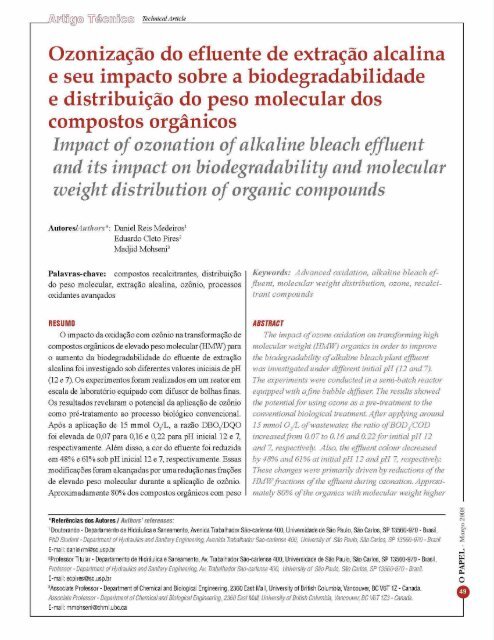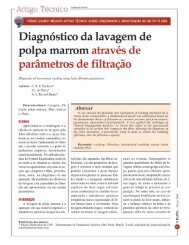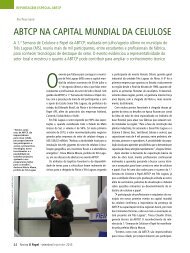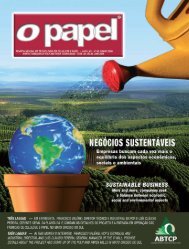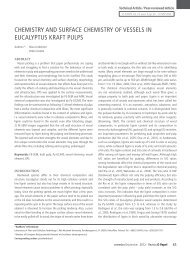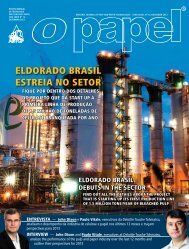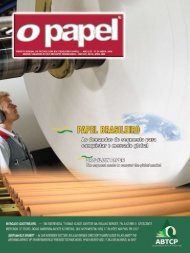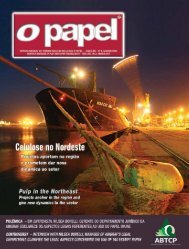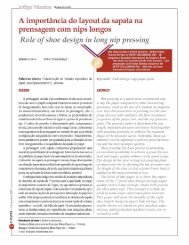Ozonização do efluente de extração alcalina e ... - Revista O Papel
Ozonização do efluente de extração alcalina e ... - Revista O Papel
Ozonização do efluente de extração alcalina e ... - Revista O Papel
Create successful ePaper yourself
Turn your PDF publications into a flip-book with our unique Google optimized e-Paper software.
O<br />
4QrjUCj Techn calArticle<br />
4zoniza ao <strong>do</strong> <strong>efluente</strong> <strong>de</strong> extra<br />
ao <strong>alcalina</strong><br />
e seu impacto sobre a bio<strong>de</strong>gradabilida<strong>de</strong><br />
ao <strong>do</strong> peso<br />
e distribui<br />
compostos organicos<br />
Autoresl trstfao s Daniel Reis Me<strong>de</strong>iros<br />
Eduar<strong>do</strong> Cleto Piresz<br />
Madjid hIohseni<br />
Palavras shave compostos recalcitrantes distribuir ao<br />
<strong>do</strong> peso molecular extrarrao <strong>alcalina</strong> ozonio processor<br />
oxidantes avanra<strong>do</strong>s<br />
RESUMO<br />
O impacto da oxidarao com ozonio na transformarao <strong>de</strong><br />
compostos organicos <strong>de</strong> eleva<strong>do</strong> peso molecularHMtiU para<br />
o aumento da bio<strong>de</strong>gradabilida<strong>de</strong> <strong>do</strong> <strong>efluente</strong> <strong>de</strong> extrar ao<br />
<strong>alcalina</strong> for irnrestiga<strong>do</strong> sob diferentes valores iniciais <strong>de</strong> pH<br />
12 e 7 Os experimentos foram realiza<strong>do</strong>s em um reator em<br />
escala <strong>de</strong> laboratorio equipacla com difusor <strong>de</strong> bolhas finas<br />
Os resulta<strong>do</strong>s revelaram o potential da aplicac ao <strong>de</strong> ozonio<br />
comopre tratamento ao processo biologico conventional<br />
Apos a aplicar ao<strong>de</strong> 1 mmol a razao 03L DHOSIDQO<br />
for elevada <strong>de</strong> 07 para016 e022 para pH initial 12 e 7<br />
respectivamente Alem disso a cor <strong>do</strong> <strong>efluente</strong> for reduzida<br />
em 4R e 61sob pH initial 12 e 7 respectivamente Essas<br />
modiflca oesforam alcan adas por umareduc aonasfra oes<br />
<strong>de</strong> eleva<strong>do</strong> peso molecular durante a aplicarao <strong>de</strong> ozonio<br />
Aproximadamente 80<strong>do</strong>s compostos organicos com peso<br />
Referencias <strong>do</strong>s Autores 1 AErthors references<br />
molecular <strong>do</strong>s<br />
Keywords Advanced oxidation alkaline bleach ef<br />
fluent molecular weight distribution ozone recalci<br />
tram cotTipounds<br />
ABSTRACT<br />
The impact ofozoneoxidation on transfor raing high<br />
molecular weight HM7 organics in or<strong>de</strong>r to improve<br />
the bio<strong>de</strong>gradabilit ofall aline bleach plant effluent<br />
was investigated un<strong>de</strong>a different initial pH 12 and<br />
The eeperiments were cons7ucted in aserrai batch reactor<br />
equippedwith afine bubble diffuser<br />
The resulis slaawed<br />
thepotentialfor using ozone as apre tF eatrrzer7t to the<br />
conventional biological treatment Af eapplying around<br />
13 mmol DMZ ofwastewater the ralxo ofBDDjICC D<br />
increasedfrom 07to016and022for initial pH 12<br />
and 7 respectively Alsorhe effluent colour <strong>de</strong>creased<br />
by8and 61 at initt al pH 12 and pH 7 respectively<br />
These changes wereprimar alydr zven byreductx ortsfthe IlYT7fractionsof the effluent during ozonation Approxi<br />
mately SO ofthe orgciTZics with molecular weight higher<br />
Doutorantlo Departamento <strong>de</strong> Hitlraulica a Saneamento Avenitla Trabalha<strong>do</strong>rSao carlense400 Universitlatle <strong>de</strong> Sao Paulo Sao Carlos SP 13560 970 Brasil<br />
PhDSfu<strong>de</strong>nf Uepart enf of Hydraulics and SanitaryEn trneerin0 AvenidaTratr lh <strong>do</strong>rSao rlenseCOQ Llnrversr yof So Paulo SaoCrlos SFi3 i60 970 Brazr<br />
Email danielrm sc usp hr<br />
Professor Titular Depaitamento tle Hitlraulica e Saneamento Av Trabalha<strong>do</strong>rSoo carlense 400 Universitlatle <strong>de</strong> Sao Paulo Sao SP<br />
Carlos 13560 970 Brasil<br />
1 i<br />
e9a 7rTe 07rl SadiaRrtal e15f17Rf JFl aflalr lwSacdE 7L t1UlVBilf rS2o aui0 S1C r ri<br />
Sr f3J60L 3ra7G<br />
EmailecpiresC 3sc usp br<br />
Associate Professor Department of Chemical and Biological Engineering 236D East Mall University of British Columbia Vancouver BC V6T 1Z Canatla<br />
ate F sso nertt cfGhen ralandBd hwrralEngn rng73ti0Cast19a11 tlnrversrly<br />
Emailmmohseni tchml ubc ca<br />
oP B rrsr Colombia Uarec terLi16T 1Z3 Canaria<br />
0<br />
N<br />
0<br />
c<br />
W
o N<br />
0<br />
C<br />
molecular superior a Kg m of foram converti<strong>do</strong>s epos a apli<br />
cao <strong>de</strong> cerca <strong>de</strong> 20 mmol <strong>de</strong> ozonio por litro <strong>de</strong> <strong>efluente</strong><br />
INTRDDU AO<br />
Os <strong>efluente</strong>s gera<strong>do</strong>s pela industria da celulose apresen<br />
tam <strong>de</strong> forma geral eleva<strong>do</strong> colorarao <strong>de</strong>vi<strong>do</strong> a presence<br />
<strong>de</strong> gran<strong>de</strong>r quantida<strong>de</strong>s <strong>de</strong> compostos<br />
clora<strong>do</strong>s <strong>de</strong>riva<strong>do</strong>s<br />
<strong>de</strong> lignina <strong>de</strong> alto peso molecular HIviW Pokhrel e ira<br />
raghavan 2004 e tambem gran<strong>de</strong> quantida<strong>de</strong> <strong>de</strong> compostos<br />
organicos biorrefratarios que contribuem Para sua baixa<br />
bio<strong>de</strong>gradabilida<strong>de</strong> Dahlman etal 1995 mostraram que a<br />
fra ao <strong>de</strong> compostos <strong>de</strong> eleva<strong>do</strong> peso molecular contri bui<br />
com cerca <strong>de</strong> 60 da DQO <strong>de</strong>manda quimica <strong>de</strong> oxigenio<br />
total presente no <strong>efluente</strong> gera<strong>do</strong> pela etapa <strong>de</strong> extra ao<br />
<strong>alcalina</strong> Alem disco estu<strong>do</strong>s recentes mostram o potential<br />
mutagenico e carcinogenico <strong>de</strong> <strong>efluente</strong>s <strong>do</strong> branqueamento<br />
<strong>de</strong> diversas industries brasileiras Rosa 1997 Apesar <strong>de</strong><br />
lidarem tomum <strong>efluente</strong> com as caracteristicas apresentadas<br />
anteriormente a maioria <strong>do</strong>s industrial <strong>de</strong> papel<br />
e celulose<br />
tem a<strong>do</strong>ta<strong>do</strong> processor biologicos Como lo<strong>do</strong>s ativa<strong>do</strong>s lago<br />
as aeradas e processor anaerobios pare otratamento final <strong>do</strong>s<br />
agues residuarias Else tipo <strong>de</strong> tratamento tem se mostra<strong>do</strong><br />
eficiente na redur ao<strong>de</strong> compostos organicos bio<strong>de</strong>gradaveis e<br />
soli<strong>do</strong>s suspensor Porem o tratamento biologico conven io<br />
nal e incapaz <strong>de</strong> eliminar a materia organica recalcitrante <strong>de</strong><br />
dificil bio<strong>de</strong>grada aoWelan<strong>de</strong>r etal 1997 e sua aplicarao<br />
<strong>de</strong> forma isolada talvez nao seja suficiente pare satisfazer os<br />
crescentes limiter na emissao <strong>de</strong> <strong>efluente</strong>s<br />
Consi<strong>de</strong>ran<strong>do</strong> seessas limitaCOes diferentes estrategias<br />
<strong>de</strong> tratamento Como a combinacrao <strong>de</strong> processor avan<br />
a<strong>do</strong>s tom processor biologicos po<strong>de</strong>riam ser a<strong>do</strong>tadas<br />
Para a melhoria da qualida<strong>de</strong> <strong>do</strong> <strong>efluente</strong> produzi<strong>do</strong> pelas<br />
industries <strong>de</strong> papel e celulose Estu<strong>do</strong>s <strong>de</strong>monstram que<br />
a oxida ao<strong>de</strong> compostos refratarios resulta<br />
em aumento<br />
da bio<strong>de</strong>gradabilida<strong>de</strong> diminuin<strong>do</strong> o tempo necessario<br />
pare a biorremecliacrao Scott e Ollis 1995 Mantzavinos<br />
e Psillikis 2004 Em particular a oxidar ao tom ozonio<br />
comopre tratamento segui<strong>do</strong> por processor biologicos<br />
tem li<strong>do</strong> estudada pare o tratamento <strong>de</strong> diversos <strong>efluente</strong>s<br />
industriais incluin<strong>do</strong> os gera<strong>do</strong>s pela<br />
industria da celu<br />
lose Mao e Smith 199 Wang et al 2004 halcioglu et<br />
al 2006 Esser estu<strong>do</strong>s mostraram que o use <strong>de</strong> ozonio<br />
comopre tratamento<br />
resultou em aumento da <strong>de</strong>manda<br />
bioquimica <strong>de</strong> oxigenio DhOS e da remar ao <strong>de</strong> tor<br />
embora pouco ou nenhuma redu ao na <strong>de</strong>manda quimica<br />
<strong>de</strong> oxigenio DQO e carbono organico total COT Alem<br />
disco estu<strong>do</strong>s revelam que a oxida aotom ozonio po<strong>de</strong><br />
converter compostos organicos <strong>de</strong> eleva<strong>do</strong> peso molecular<br />
HMW em compostos <strong>de</strong> baixo peso molecular LMW<br />
there 5 Kg rnol were converted after applying arour7d<br />
20 mmol cf ozone per liter of wastewater<br />
INTROD ICTION<br />
Bleaching plant effluents are usuall7 hzgh<br />
ly coloured due to the preser2ce of elevated<br />
arraourzts ofhigh molecrrlar weightH1IY<br />
chlorinated ligr2iva <strong>de</strong>rivatives Pakhrel and<br />
hiraraghavara 2000 arzd rich ire biorefractory<br />
amounts ofbiorefracto organic compounds<br />
which contribute to its poor bio<strong>de</strong>gradability<br />
Dcalalmarr et al 1995 showed thatHll IYTIcona<br />
poua ds cor2tr ibute to about 60 ofthe COD of<br />
an alkaline bleach effluent In addition studies<br />
have shown the mutagenic arad carcinogenic<br />
potential of bleaching effluents from Brazil<br />
ian pulp mills Rosa 19971revertheless most<br />
industries have a<strong>do</strong>pted biological processes<br />
such as activated sludge aerated lagoor z ar2d<br />
anaerobr cprocessesfor wastewatertre atrraent<br />
These processes have been effectively usedfor<br />
re ducirag bio<strong>de</strong>gradable organic compounds<br />
and suspen<strong>de</strong>d solids However they are unable<br />
to eliminate hardly recalcitrant bio<strong>de</strong>gradable<br />
orgara icmatter Welanc er et al 1997 arzd may<br />
riotbe eraou gh to satisfy the increasi rglydi s<br />
clzarge limitre rtrictioras<br />
Corasi<strong>de</strong>r irag these limitations different<br />
treatment strategies such as the eornbirzation<br />
ofadvanced oxidation proce sse s aid biologi<br />
cal process could be a<strong>do</strong>pted to irraprove the<br />
quality ofpulp ar2d paper mills wastewater<br />
Oxidation ofrefr actort compounds has been<br />
<strong>de</strong>monstrated to result irr bio<strong>de</strong>gradability erz<br />
haracement <strong>de</strong>creasing the necessary timefor<br />
biorerraediation Scott and Dllis 1993 Alant<br />
aavinos arzd Psillkis 2000 Ire particular the<br />
use ofozone oxidation as apre treatmentfol<br />
lowed by biological process has been studied<br />
for the treatment f many radustr ial wastewa<br />
ters including those gevaer atedfrom pulp trains<br />
slilao andbmith 1995tt ang et al 200<br />
Balcioglu et al 2006 These studies have<br />
shovers that the use of ozone as apre treatment<br />
was effective at increasing bioch ernical<br />
oxygen<br />
<strong>de</strong>naarad BOD arzd removing colour <strong>de</strong>spite<br />
little orro reduction iva cherraical oxygen <strong>de</strong><br />
mand COD arzd total organic carbon TOC<br />
Also studies have shown that ozone oxidation
O<br />
resultan<strong>do</strong> em aumento da bio<strong>de</strong>gradabilida<strong>de</strong> Bijan e<br />
Mohseni 2005 Morals et cal 2007 Compostos <strong>de</strong> baixo<br />
peso molecular ten<strong>de</strong>m a ser mais hiclrofilicos resultan<strong>do</strong><br />
em maior biodisponibilida<strong>de</strong> enquanto que a presen a<strong>de</strong><br />
Compostos <strong>de</strong> eleva<strong>do</strong> peso<br />
molecular leva a uma maior<br />
recalcitrancia <strong>de</strong>vi<strong>do</strong> a natureza aromatics ehi ofobica<br />
cla m ateria organics Kerc et al 2004<br />
A analise da distribuirao <strong>do</strong> peso molecular po<strong>de</strong><br />
revelar a resposta e o comportamento<br />
<strong>de</strong> diferentes<br />
fra oes durante o processo <strong>de</strong> oxidac ao Wang et al<br />
2006 Neste estu<strong>do</strong> foi investigada a distribui ao <strong>do</strong><br />
peso molecular <strong>do</strong>s Compostos organicos presentes no<br />
<strong>efluente</strong> gera<strong>do</strong> pela etapa <strong>de</strong> extra ao<strong>alcalina</strong> <strong>do</strong> bran<br />
queamento ap6s ser submeti<strong>do</strong> a diferentes <strong>do</strong>ses <strong>de</strong><br />
ozonio sob diferentes valores iniciais <strong>de</strong> pH atraves da<br />
utiliza ao <strong>de</strong> cromatografia <strong>de</strong> exclusao par tamanho <strong>de</strong><br />
alto <strong>de</strong>sempenho HPSEC Diferentes frar oes <strong>de</strong> peso<br />
molecular foram obtidas e quantificadas A partir <strong>do</strong>s<br />
resulta<strong>do</strong>s obti<strong>do</strong>s concluiu se que aplicar ao<strong>de</strong> ozonio<br />
e um meto<strong>do</strong> eficiente especialmente na conversao <strong>de</strong><br />
Compostos recalcitrantes <strong>de</strong> eleva<strong>do</strong> peso molecular<br />
presentes no <strong>efluente</strong> da industria <strong>do</strong> papel e celulose e<br />
no aumento <strong>de</strong> sus bio<strong>de</strong>gradabilida<strong>de</strong><br />
MATERIAIS E METDDDS<br />
Para a realizar ao <strong>de</strong>ssa pesquisa<br />
foram utilizadas<br />
amostras <strong>de</strong> <strong>efluente</strong> gera<strong>do</strong> na etapa <strong>de</strong> extrar ao<strong>alcalina</strong><br />
<strong>do</strong> branqueamento da celulose fornecidas pela industria<br />
Howe Sound Pulp and Paper localizada na provincia <strong>de</strong><br />
British Columbia Canada Essa industria produz cerca<br />
<strong>de</strong> 350 000 toneladas <strong>de</strong> celulose Kraftobtida principal<br />
mente <strong>de</strong> Western Hemlock O processo <strong>de</strong> branquea<br />
mento e realiza<strong>do</strong> em 5 estagios00 DEop DED e o<br />
<strong>efluente</strong> foi caracteriza<strong>do</strong> assim que recebi<strong>do</strong> e armaze<br />
na<strong>do</strong> a 4C ate a sus utilizar aoA Tabela I apresenta as<br />
Tabela 1 Caracteristicas iniciais <strong>do</strong> <strong>efluente</strong> <strong>de</strong> extra ao<strong>alcalina</strong><br />
bfe 1lr itilch racfetrstr cf the alk3lir7ebt rh effluerf<br />
pH<br />
Alcalinida<strong>de</strong> total mgCaCO3lL I Tofal alkaliraify angCaC03tJ<br />
Cor UCI CalUUr CUj<br />
ccan convert high molecular weight H1v1T Y<br />
organics into low molecular weight ZMW<br />
compounds resulting in bio<strong>de</strong>gradability en<br />
hancement Bijan and llohseni 2005 Morais<br />
et al 200 J LlI ILV molecules tend to be more<br />
hydrophilic resulting iaz greaterbr oavailabil<br />
ity whereas the presence ofH1TY compounds<br />
leads to amore recalcitrance due to the aro<br />
matic and hydrophobic nature ofthe organic<br />
matter Kerc et al 2004<br />
lulolecular weight distributa onanalysis can<br />
reveal the response and behavior of different<br />
fractions during oxidation processes LT ang et<br />
al 2006J In this study the molecular weight<br />
clista ibutionf the organic compounds pre se nt<br />
in an alkaline bleach plant effluent after receiv<br />
ing dzffererzt <strong>do</strong>ses of ozone at different initial<br />
pH was investigated using high performance<br />
size exclusion chromatography HPSEC Dif<br />
ferent molecular weight ranges were obtained<br />
and quantified From these results it was pos<br />
sible to conclu<strong>de</strong> that tlae application of ozone<br />
is an effective method especially at converting<br />
the HlulYtr recalcitrant compounds present in the<br />
pulp and paper wastewater and increasing its<br />
bio<strong>de</strong>gradability<br />
MATfR1ALS ANd MfTAODS<br />
fllkaline bleach plant effluent was obtainedfrom<br />
Howe Sound Pulp arzd Paperlill in British Co<br />
lumhia Canada The rraillpr oduces about 350 000<br />
tonnes ofkrcft pulp annually mainly fS om Western<br />
Hemlock softwood The bleachingpa ocess consists<br />
of5 stagesYJO DEop LEDJand the effluent was<br />
fully analyzed upon receipt and stored at4C until<br />
COT mglL TOCmg LJ 1970 35<br />
DQO mglL COD anyiLJ 4782 45<br />
DBDS mglL BOD mg LJ 338 45<br />
DBDSlDOO IBOD CD 07 009<br />
Compostos cam MW 1 Kg mol o lCo npot rnr suith ti9f J 1 Kgr1 1 65 75<br />
11<br />
1621<br />
4031<br />
0<br />
N<br />
0<br />
L<br />
W
e<br />
e<br />
f<br />
l<br />
u<br />
e<br />
n<br />
t<br />
o N<br />
0<br />
C<br />
caracteristicas iniciais <strong>do</strong><br />
Os experimentos foram realiza<strong>do</strong>s<br />
em um reator<br />
acrilico tubular com 7 cm <strong>de</strong> diametro interno e 20<br />
cm <strong>de</strong> altura equipa<strong>do</strong> com um difusor localiza<strong>do</strong> na<br />
sue parte inferior Figure 1 O ozonio foi produzi<strong>do</strong><br />
por um gera<strong>do</strong>r <strong>de</strong> ozoniol2o<strong>de</strong>lo RMU16 lbAZCO<br />
Ind Canada a partir <strong>de</strong> ar rico em oxigenio Uma<br />
unida<strong>de</strong> <strong>de</strong> Adsorr aocom Alternancia <strong>de</strong> Pressao PSA<br />
Nlo<strong>de</strong>loAS 12 AIRSEP Corp USA foi utilizada<br />
para elevar a concentra ao<strong>de</strong> oxigenio no ar e remover<br />
impurezas O gera<strong>do</strong>r <strong>de</strong> ozonio produz gas<br />
continua a uma concentraCao <strong>de</strong>104<br />
<strong>de</strong> forma<br />
x 103mmol mL<br />
utilizan<strong>do</strong> se uma vazao <strong>de</strong> 500 mL min O gas nao<br />
consumi<strong>do</strong> no reator foi quantifica<strong>do</strong> e <strong>de</strong>strui<strong>do</strong> por<br />
um analisa<strong>do</strong>r <strong>de</strong> ozonio Ma<strong>de</strong>loHA 200GTP Rankin<br />
Ozone Systems Ltd Canada<br />
Procedimento experimental<br />
A ozoniza ao foi realizada a temperature ambiente<br />
<strong>de</strong> 23 C em amostras <strong>do</strong> <strong>efluente</strong> com valores iniciais <strong>de</strong><br />
pH ajusta<strong>do</strong>s para 12 e 7 O ajuste <strong>do</strong> pH<br />
foi realiza<strong>do</strong><br />
utilizan<strong>do</strong> seNaOH e HC1 O processo <strong>de</strong> oxida ao foi<br />
realiza<strong>do</strong> em batelada utilizan<strong>do</strong> se 500 mL <strong>de</strong> <strong>efluente</strong><br />
sob diferentes intervalos <strong>de</strong> tempo Ao final <strong>de</strong> ce<strong>de</strong> tempo<br />
to<strong>do</strong> o volume foi retira<strong>do</strong>para analise A concentra ao<strong>do</strong><br />
ozonio nao consumi<strong>do</strong>off gas foi coletada e quantificada<br />
em intervalos <strong>de</strong> 15 segun<strong>do</strong>s atraves <strong>do</strong> analisa<strong>do</strong>r <strong>de</strong> ozo<br />
nio e plotada versus tempo A curve obtida foi integrada<br />
para<br />
estimative <strong>do</strong> ozonio total nao consumi<strong>do</strong> A <strong>do</strong>se<br />
use Table I shows the efftuenr properties<br />
Ozone oxidation experiments were carried out in a<br />
semi batch bubble column reacior Plexiglas height<br />
20 cm internal diamer er 7 crn equipped with aJive<br />
bubble diffuser at the bottom as shown in Figure 1<br />
PSA Pressure swing adsorptrorz llo<strong>de</strong>l 4S1AIR SEP<br />
Corp LTS was resed to increase oxygen concentration in<br />
the air andto remove impuritiesfrom the gas phase The<br />
oxygen richair was sent to an ozone generator Mo<strong>de</strong>l<br />
RMLII16 ZCO Ind Canaawhere ozone was pro<br />
ducedconr inuousl at aconcentration of104x 103mmoll<br />
neL at afloy rate of500 mLirnin The exhaust gas stream<br />
from the top ofthe ozone reactorpassedthrough an ozone<br />
analyzer Mo<strong>de</strong>lHA 200GTP Rankin Ozone Sysiems Ltc<br />
Canada where flee ozone was guant ed and <strong>de</strong>stroyed<br />
before being releasedto theem ironment<br />
Experinsentul procedrare<br />
Ozonation experiments were conducted at initial<br />
efJiuent pH 12 and 7 and at 23 Croom temperature<br />
The adjustment of wastewater pH was <strong>do</strong>ne using<br />
NaDH andHCI Batch experiments were conducted<br />
on 500 mLof Nastewater at different time inters alsAt<br />
the end of each cle the entire olume was taken for<br />
analysis Ozone concentration in the off gas was col<br />
lected every I5 seconds interval using the ozone ana<br />
lyzer The off gas concentration was plotted against<br />
timefor each ozonation time The curti e obtained was<br />
integrated to estimate the totalnon consumed ozone
O<br />
aplicada <strong>de</strong> ozonio foi calculada com base na diferenc a<br />
entre o ozonio aplica<strong>do</strong> e o n2o consumi<strong>do</strong> por unida<strong>de</strong> <strong>de</strong><br />
volume <strong>de</strong> <strong>efluente</strong> no rector A concentra ao<strong>de</strong> ozonio<br />
residual na fase liquida tambem foi analisada e subtraida<br />
Para a obten ao <strong>de</strong>s <strong>do</strong>se <strong>de</strong> ozonio<br />
1tileto<strong>do</strong>s Analiticos<br />
Foram medi<strong>do</strong>s DBOS e DQO <strong>de</strong> acor<strong>do</strong> com os Stan<br />
dard Methods 5210B e 5220D respectivamente APHA<br />
1998 Carbono Organico Total COT foi <strong>de</strong>termina<strong>do</strong><br />
pormeio <strong>de</strong> analisa<strong>do</strong>r <strong>de</strong> COTTOC 1CPH Shimadzu<br />
O pH foi medi<strong>do</strong> com pHmetro PerpHecT mo<strong>de</strong>lo 330<br />
Thermo Orion Cor foi medida <strong>de</strong> acor<strong>do</strong> com o meto<strong>do</strong><br />
H5 <strong>de</strong>s Canadian Pulp and Paper Association CPPA<br />
1993 O ozonio residual na fase liquida<br />
foi <strong>de</strong>termina<strong>do</strong><br />
segun<strong>do</strong> o meto<strong>do</strong> indigo colorimetrico Standard Me<br />
thod 4500 O3B APHA 1998 com modifica oesAs mudan as na bio<strong>de</strong>gradabilida<strong>de</strong> foram <strong>de</strong>terminadas<br />
pela razao DBOS DQO<br />
A analise <strong>de</strong>s distribuiCao <strong>do</strong> peso molecular foi re<br />
alizada por HPSEC High Performance Size Exclusion<br />
Chromatography atraves <strong>do</strong> meto<strong>do</strong> <strong>de</strong>scrito por Peleka<br />
ni et al 1999 Para tanto utilizou se um HPLC High<br />
Performance Liquid Chromatography mo<strong>de</strong>lo Waters<br />
1535 equipa<strong>do</strong> com uma calunataters Protein PakTiVi<br />
125 1 e um <strong>de</strong>tector <strong>de</strong> absorbancia Waters 2487 ajusta<br />
<strong>do</strong> pares <strong>de</strong>tecrao a 260nm A vazao aplicada foi <strong>de</strong> 0J<br />
mL min LTtilizou se coma eluente uma soluc ao 02 M<br />
<strong>de</strong> fosfato Fisher Scientific com pH igual a 68 e fora<br />
ionica ajustada a 01 M atraves <strong>do</strong> use <strong>de</strong> cloreto <strong>de</strong> sodio<br />
Fisher Scientific O peso molecular foi relaciona<strong>do</strong> com<br />
o tempo <strong>de</strong> retenc aoatraves <strong>de</strong> uma calibra aoprevia<br />
com compostos padroniza<strong>do</strong>s <strong>de</strong> poliestireno sulfona<strong>do</strong><br />
7 Kg mol PSS7K 4 Kg mol PSS4K 2 Kg mol PSS2K<br />
American Polymer Standards Corporation e acetones 58<br />
g mol CertifiedACSFisher Scientific a uma con<br />
centrar ao<strong>de</strong> 1 mg L Apos a regressao a rela ao entre<br />
o peso molecular y Da e o tempo <strong>de</strong> retenr aox min<br />
foi <strong>de</strong> y 4106e07336 R2 099Essa rela ao foi utilizada<br />
pares estimative <strong>do</strong> peso molecular <strong>do</strong> cromatograma<br />
Todas as amostras foram previamente<br />
filtradas antes <strong>de</strong><br />
serem injetadas ao HPLC Foram utiliza<strong>do</strong>s filtros com<br />
poros <strong>de</strong> 045mllvlillipore Millex Um volum e <strong>de</strong> 250<br />
L foi injeta<strong>do</strong> manualmente e elui<strong>do</strong> por 20 minutos<br />
O cromatograma <strong>de</strong>s distribui ao<strong>do</strong> peso molecular<br />
obti<strong>do</strong> pela analise com o HPSEC foi posteriormente<br />
dividi<strong>do</strong> em diferentes picos e sues area foi quantificada<br />
utilizan<strong>do</strong> seum software PeakFit412 Systat Software<br />
Inc O valor numerico apresenta<strong>do</strong> foi utiliza<strong>do</strong> pares<br />
Ozone <strong>do</strong>sage was calculated based on the difference<br />
ofapplied andnon consumed ozone per unit volume<br />
of the wastewater to the reaetox Residual ozone con<br />
centration in the liquid phase was also analyaed and<br />
suhtracted to obtain the ozone <strong>do</strong>sage<br />
ltzalytical lletl ods<br />
411 the samples were subjected to COD TOC BODs<br />
colour and molecular weight dzs2ribution analysis BOD j<br />
and COD measurements were perfol med according<br />
to StandardIt lethods 5210B and 5220D respectively<br />
APHA 1995 Total orgarar cca rbora was measured usi ag<br />
a TOC analyzer TOC 5050ShimadzuJ The valuesof pH<br />
were measured by a pH meter PerpHecT meter Mo<strong>de</strong>l<br />
330 Thermo Orion Colour was measured based on the<br />
proposed standard method HS reported by the Carurdian<br />
Pulp and Paper Association 1 Q93 Residual<br />
ozone irz<br />
the liquidphase was <strong>de</strong>termined according to Standard<br />
Illethocls X500 OBAPHA 19961 with modificatioTas<br />
HPSEC was employed to <strong>de</strong>termine the molecular<br />
weight distrlhution in untreated and treated samples<br />
Following the method <strong>de</strong>sc ibed vy<br />
Pelekani et al<br />
1999 aFT esters 1535 Binary HPLC Pumpfatted with a<br />
YT atersProtein Pakr 125 column anda YT aters 2457<br />
17ua1 Absorbance Detector set to <strong>de</strong>tection at 2150<br />
Cana was usedfor HPSEC analysis The carriersolvent<br />
consiste<strong>do</strong>f02Mphosphate vufferLaborator gra<strong>de</strong><br />
FisherScient catpH6 5adjustedwithsodiumclalo<br />
ri<strong>de</strong> CertifiedACSFisher5cieniifc io011 ionic<br />
strength The column flow ate applied<br />
was 07 mLi<br />
mi z Molecular weight was correlated to retention time<br />
jr calibration with polystyrene sulforta testandards 7<br />
Kg mol PSS7K 4Kg mol PSS4h 2 Kg naol PSS2<br />
American PolymerStaradards Corporation andacetone<br />
55 g molCert edA CS Fisher Scient cat con<br />
centration of 1 gL After regression the relationship<br />
ofmolecular weight y Da andreteration time x min<br />
was y 410 eaz R 099 This relationship was<br />
used to estimate themolecu<br />
larweightdistrihution ofthe<br />
chroarzatogram Standards and samples before andafter<br />
oxidation were filtered before injection usingalllillipore<br />
1lillex nonsler<strong>de</strong> syringefilters045une pore size PTL7F<br />
menabr xne to remove particles 4 sample volume of 250<br />
uL was manually ii2jected inforhe 50 uL sampling loop<br />
oftdae HPLC sand elutedfor 2D minutes<br />
Aaonlinear curvefitt7 ngsoftware FeakFit412<br />
Systat Software Irac using a Caussiara responsefunc<br />
tion with aFourier <strong>de</strong>convolution algorithm wasused<br />
to divi<strong>de</strong> the chromatogram into different peaks and<br />
0<br />
N<br />
0<br />
L<br />
W
00<br />
0<br />
0<br />
N<br />
0<br />
z<br />
C<br />
quantificar as modificar oes causadas pela aplica ao<br />
<strong>de</strong> ozonio sobre a distribuir ao<strong>do</strong> peso molecular <strong>do</strong>s<br />
compostos organicos<br />
RESULTADOS E DISCUSSAO<br />
A eficiencia da aplicac ao<strong>de</strong> ozonio para o tratamento<br />
<strong>do</strong> <strong>efluente</strong> gera<strong>do</strong> pela etapa <strong>de</strong> extrac ao <strong>alcalina</strong> <strong>do</strong><br />
branqueamento da celulose foi investigada sob diferentes<br />
valores iniciais <strong>de</strong> pH 12 e7A concentraCao <strong>de</strong> ozonio<br />
dissolvi<strong>do</strong> na fase liquida nao foi significativa em todas<br />
as <strong>do</strong>ses aplicadas A concentrac ao<strong>de</strong> ozonio absorvi<strong>do</strong><br />
pelo <strong>efluente</strong> foi maior a pH mais eleva<strong>do</strong> A ozoniza<br />
rao a pH inicial 7 por 35 minutos resultou em uma <strong>do</strong>se<br />
absorvida <strong>de</strong> ozonio em torno <strong>de</strong> 15 mmol03 por litro <strong>de</strong><br />
<strong>efluente</strong> enquanto que a aplicac ao <strong>de</strong> ozonio pelo mesmo<br />
tempo an <strong>efluente</strong> com pH inicial igual a 12 resultou em<br />
uma <strong>do</strong>se <strong>de</strong> 25 mmol03por litro <strong>de</strong> <strong>efluente</strong><br />
A Figura 2 os apresenta valores da cor <strong>do</strong> <strong>efluente</strong><br />
apos a oxidac ao em func ao <strong>do</strong> ozonio consumi<strong>do</strong> A<br />
ozonizar aofoi altamente eficiente na remo ao <strong>de</strong> cor<br />
<strong>do</strong> <strong>efluente</strong> estuda<strong>do</strong> A pH inicial 12 a cor <strong>de</strong>cresceu<br />
<strong>de</strong> 4000 UC unida<strong>de</strong>s <strong>de</strong> cor para cerca <strong>de</strong> 2000<br />
UC enquanto que a pH inicial 7<br />
a cor foi reduzida<br />
para aproximadamente 1500 UC com <strong>do</strong>se consumida<br />
<strong>de</strong> ozonio <strong>de</strong> cerca <strong>de</strong> 16 mmol03por litro <strong>de</strong> <strong>efluente</strong><br />
Esses resulta<strong>do</strong>s sao consistentes com estu<strong>do</strong>s previos<br />
que mostram uma eleva<strong>do</strong> remorao <strong>de</strong> cor <strong>de</strong> <strong>efluente</strong>s<br />
industriais durante a oxida ao com ozonio Alvares et<br />
al 2001 Bijan e Mohseni 2005<br />
Apesar da significativa redu ao da cor a <strong>de</strong>manda<br />
quimica <strong>de</strong> oxigenio DQO <strong>de</strong>cresceu <strong>de</strong> forma pouco<br />
pronunciada com o aumento da <strong>do</strong>se <strong>do</strong> ozonio para<br />
ambos os valores <strong>de</strong> pH inicial Figura 3 A DQO foi<br />
reduzida <strong>de</strong> 4782 mgrL para cerca <strong>de</strong> 4000 mg L apos<br />
a<br />
Ca<br />
0<br />
450D<br />
4D00i<br />
3500<br />
30DD<br />
25DD<br />
200D<br />
150D<br />
10DD<br />
1DDD 5D 10 150 20 250 3D0 35 0<br />
Dose <strong>de</strong>ozonio mmol 031Lz<br />
Ozaste Jasar emmod D L<br />
Figura 2 Car <strong>do</strong> <strong>efluente</strong> da extrarao <strong>alcalina</strong> durante a ozo<br />
nizacao pH 7 pH 12 Fir tre2 Colour oftlkalirle<br />
xtrartron effluent ddurinc ozonatrorr IH 7iItH i2<br />
quarztafy the area This nurnel zcal value was used to<br />
quantify the changes caused by ozonation ore the rno<br />
lecula weight distribution of orgaraie compounds<br />
BfSULTS AND DISCUSSION<br />
The efficiency ofozone applied to thetr eat<br />
ment ofalkaline bleach plant wastewater at dif<br />
ferent initialpH values pH 12 arrd pH 7<br />
was ex<br />
amined Ira this study Dis solti e<strong>do</strong>zone concentra<br />
tion in the liquid phase was notsign ficantjor all<br />
<strong>do</strong>sages applied The absorbed amount of ozone<br />
in the wastewater exhibited an incr ease when the<br />
initr al pH ofthe effluent was higher Ozonation<br />
of wastewater with initial pH 7 for<br />
35 minutes<br />
showed an absorbed <strong>do</strong>se ofabout I5 mmol0<br />
Lw whereas the sarrre time appliedfor pH 12<br />
wastewater resulted in an absorbed <strong>do</strong>se ofabout<br />
25 namol0 Lw<br />
Figure 2 shows the colous values of the<br />
wastewater after oxidation as a firnctiorz of the<br />
consumed ozov<br />
e Ozonation is highly effective<br />
in removing colour of the studied wastewater At<br />
initial pH 12 colour values <strong>de</strong>creasedfrom 4000<br />
C U to around 200D C U whereas at initial pH<br />
7 colour <strong>de</strong>creased toat ound 1500 C U with a<br />
consumed ozone of about 16 mmol0 L These<br />
wn<br />
results tre consistent with previous studies that<br />
showed high <strong>de</strong>colourization of industrial efflu<br />
ents during ozone oxidation Alvares et al X001<br />
Bijanandlohserai 00<br />
Despite the significant reduction ofcolour<br />
COD <strong>de</strong>creased slightly with increasing the<br />
ozone <strong>do</strong>sage for both initial pH Figure 3 COD<br />
<strong>de</strong>creasedfrom 4i82 mg L to around 4000 mglL<br />
s a<br />
O<br />
O<br />
O<br />
O<br />
o<br />
O<br />
fJ<br />
i<br />
Dose <strong>de</strong> ozonio mmol D Lz1uci<br />
Ozr ran<br />
Csar emr tarG u1<br />
Figura 3Variarao da DQO <strong>do</strong> <strong>efluente</strong> emfun ao da <strong>do</strong>se <strong>de</strong><br />
oz8nio consumida pH 7 pH 12 Barra <strong>de</strong> erros <strong>de</strong>svio<br />
padr oI Figr3 COD of btearh plar7t eftluer7t Itrrrnct ocr7a<br />
tlor7JjH 7J pH 12 Error bars sfandard <strong>de</strong>viation
1<br />
t<br />
0 1<br />
U<br />
F<br />
U<br />
Dose da azonio mmol D3 I Lnut<br />
t7rare sage rrarrral t LJ<br />
C<br />
O<br />
O<br />
00<br />
a<br />
I I<br />
Dose <strong>de</strong> ozonic mmol 01Lr<br />
CJzane osaya mr ce D iJ<br />
Figure 4Varia ao <strong>do</strong> COT <strong>do</strong> <strong>efluente</strong> emfun ao da <strong>do</strong>se <strong>de</strong> Figura 5 Variacaa da razao <strong>do</strong> <strong>efluente</strong> durante o<br />
DBOSIDQO<br />
azonioconsumida pH 7 pH 12 Barra <strong>de</strong> erros <strong>de</strong>svio processa <strong>de</strong>azoniza ao pH 7 pH 12 Barra <strong>de</strong> error <strong>de</strong>s<br />
padrao iFl ttr TtftJr eaeliflateff ttent during ozone via padrao tr Mat CrC7ofLfefh1atieffluertclurrn r<br />
tint oH 7 j oH 12 Error bars standard <strong>de</strong>viation czctanonJoN 7 pH 12 Error bars standard <strong>de</strong>viation<br />
a aplica ao <strong>de</strong> 15 mmolO3 par litro <strong>de</strong> <strong>efluente</strong> uma<br />
remar aa em torna <strong>de</strong> 16 Essa na redur aa DQO nao<br />
foi resulta<strong>do</strong> <strong>de</strong> mineralizar ao <strong>do</strong>s compostos organicos<br />
uma vez que nao foram observadas mudanCas signifi<br />
catieas na analise <strong>de</strong> carbono organico total COT <strong>do</strong><br />
<strong>efluente</strong> Figura 4 a partir da <strong>do</strong>se <strong>de</strong> ozanio aplicada<br />
reduCao na DQO foi resulta<strong>do</strong> <strong>de</strong>s mudanCas no esta<strong>do</strong><br />
<strong>de</strong> oxida ao da carbono presente na m ateria organica<br />
A rea ao entre o azonio ou radical hidroxila<br />
cam as<br />
compostos organicos aumenta seu esta<strong>do</strong> <strong>de</strong> oxidaCao<br />
atraves da quebra <strong>de</strong> sue estrutura quimica e adi ao <strong>de</strong><br />
axigenio a sues molecules Bailey 1982 A maioria <strong>do</strong>s<br />
estu<strong>do</strong>s realiza<strong>do</strong>s cam <strong>efluente</strong>s industriais apresenta<br />
um a baixa eficiencia na m ineralizaraa a partir da aplica<br />
ao <strong>de</strong> azonio incluin<strong>do</strong> as <strong>efluente</strong>s <strong>do</strong> branqueamenta<br />
da polpa celulosica Kunz et al 2002<br />
A razao DBOS DQO fai utilizada para <strong>de</strong>terminer a<br />
por ao<strong>de</strong> no compostos organicos bio<strong>de</strong>gradaveis <strong>efluente</strong><br />
Essa razao permite uma comparar aoentre a quantida<strong>de</strong><br />
<strong>de</strong> oxigenio requerida par microarganismos para oxida<br />
rao cam o total <strong>de</strong> oxigenio requerida para umaoxida ao<br />
quimica <strong>do</strong>s compostos presentee na am ostra A caracte<br />
riza ao inicial <strong>do</strong> <strong>efluente</strong> mostrouum valor <strong>de</strong> DBOS sig<br />
nificativamente menor<strong>do</strong> que o valor <strong>de</strong> DQO indican<strong>do</strong><br />
um <strong>efluente</strong> <strong>de</strong> dificil bio<strong>de</strong>grada aaOs resulta<strong>do</strong>s da<br />
razao DBO DQO Figura 5 mostram que a ozanizar ao<br />
fai eficiente no aumento dabioclegradabilida<strong>de</strong> <strong>do</strong> <strong>efluente</strong><br />
para as experimentos conduzidas cam cliferentes valores<br />
iniciais <strong>de</strong> pH Para pH inicial igual a 12 essa razao au<br />
mentou <strong>de</strong> 06 para 016 enquanto que para pH inicial<br />
7BODS COD aumentou cle 07 para aproximadamente<br />
022 O aumento na DBOS praporcionou a contributgao<br />
mars significative para o aumento da bio<strong>de</strong>gradabilida<strong>de</strong><br />
after apph ing 15 mmolO3 Lw aremoval of<br />
about 10 This slight reduction in COD was<br />
not the result of mineralization ofoganics cas<br />
there was zo change in the TOC of the wastewa<br />
ter over the range of ozone <strong>do</strong>sage Figure 4<br />
Rather it wcas the result of the changes in the ox<br />
idatian state of the carhop in the organic matter<br />
T1ae reaction of ozone or oxidising radicals with<br />
organic compounds enhances the oxidation state<br />
by breaking their cherraica lstruct ureand adding<br />
oxt gen to the rrzolecules Bailey 1982 host of<br />
the published studies have shown that ozonation<br />
is not effective for tlae mineralization of different<br />
industrial wastewaters including bleach plant<br />
effluents Kunz et al 2002<br />
TdaeBOD COD ratz o was7sed to <strong>de</strong>termine the<br />
portion ofbio<strong>de</strong>gradable orgaazics in the wastewater<br />
This ratio allows comparing the amount ofoxygen<br />
required for oxidation by microorganisms kith the<br />
total oxygen required for cherraical oxidatr onofthe<br />
compounds present in the sample Initial char xcter<br />
izar ion ofthe alkaline bleachplant effluent showed<br />
sign canily lowerBOD than COD indicating that<br />
the wastewater is hardly bio<strong>de</strong>gr adablQ Theresults of<br />
bioc egradabdity ratios Figure S show thatozonc tron<br />
was efficient in improving the bio<strong>de</strong>gradability of the<br />
euentfor the experiments conduetec lun<strong>de</strong>r differ<br />
ent initialpH For initialpH l2 this ratio increased<br />
from 00ip to 01 whereas forpH 7 BOD COD<br />
increasedfrom 0 to022 The increase rraBOD<br />
prrn z<strong>de</strong>d the <strong>do</strong>minant contribution to the bio<strong>de</strong>grad<br />
abilityerah ancement consi<strong>de</strong>ring that COD <strong>de</strong>creased<br />
to a very limited extent BODE increase could be at<br />
0<br />
N<br />
0<br />
W<br />
O
mot<br />
0<br />
0<br />
N<br />
0<br />
C<br />
consi<strong>de</strong>ran<strong>do</strong> a limitada remorao <strong>de</strong> DQO O aumento<br />
na DBOS po<strong>de</strong> ser atribui<strong>do</strong> a redurao ou eliminarao <strong>de</strong><br />
alguns compostos toxicos presentes no <strong>efluente</strong>eou a<br />
forma ao <strong>de</strong> subprodutos com menor peso molecular e<br />
<strong>de</strong>ssa forma mail facilmente bio<strong>de</strong>gradaveis<br />
Com pH inicial igual a 7 asrea oes diretasen olvenda 0<br />
ozonio molecular e asrear oes oxidativas avanradas indiretas<br />
com o radical hidroxila OH sao igualmente importantes<br />
para a <strong>de</strong>gradar ao<strong>de</strong> compostos organicos Langlais et al<br />
1991 Entretanto sob pH 12 as reac oes envolven<strong>do</strong> o radical<br />
hidroxila se tornam mais <strong>do</strong>minantes <strong>de</strong>vi<strong>do</strong> a rapida utili<br />
zar ao <strong>do</strong> ozonio para a formaCao <strong>de</strong>sses radicais Apesar <strong>de</strong><br />
os radicais hidroxila gera<strong>do</strong>s a eleva<strong>do</strong>s valores <strong>de</strong> pH apre<br />
sentarem altas taxas ao reagirem com diversos compostos<br />
organicos esse estu<strong>do</strong> sugere que a oxidar ao realizada sob<br />
condi oesneutras apresentou mesmo que <strong>de</strong> forma pouco<br />
pronunciada melhores resulta<strong>do</strong>s clo que a oxidarao realizada<br />
com pH inicial igual a 12 Esse fato po<strong>de</strong> ser explica<strong>do</strong> pela<br />
afinida<strong>de</strong> entre os compostos recalcitrantes e responsaveis<br />
pela colorar ao<strong>do</strong> <strong>efluente</strong> com o ozonio molecular disponi<br />
vel sob pH 7 Assim os experimentos conduzi<strong>do</strong>s com pH 7<br />
produziram maiores remo oes<strong>de</strong> cor e aumento <strong>de</strong> bio<strong>de</strong>gra<br />
dabilida<strong>de</strong> Por outro li<strong>do</strong> com valores <strong>de</strong> pH eleva<strong>do</strong>s os<br />
radicais hidroxila po<strong>de</strong>riam reagir indiscriminadamente com<br />
to<strong>do</strong>s os compostos presentes na <strong>efluente</strong> compcarbonatos<br />
e bicarbonatos presentes em elevada concentra ao<br />
Distribui ao<strong>do</strong> peso molecular<br />
A Figura 6 apresenta a clistribuiCao <strong>do</strong> peso molecular<br />
clo <strong>efluente</strong> antes e apos a apliea ao cle diferentes closes<br />
tzbuted to the reductr ora ofsome toxic compounds<br />
present in the effluent andlor theforneation ofproducts<br />
with smaller molecular weights<br />
4tpH7 directreaetiorz<br />
ithmolecularozonearadad<br />
vance<strong>do</strong>xidation reactions involving H are expected<br />
to be equally importantfar the <strong>de</strong>gradation oforganic<br />
compounds Langlais et al 1991 4tpH 12 howevea<br />
reactions involving OH become mare <strong>do</strong>minantbecause<br />
ofthefastozone usage for radicalsformation The initia<br />
tion reaction between ozoneandhydroxi<strong>de</strong> ion preserrtin<br />
alkaline solutions could reduce the amount ofmolecula<br />
ozone vailable for selective and direct reactions with<br />
some speck compounds Despite thefact that OHgerr<br />
erated at higher pH havesign cantly higher rate con<br />
stants when reacting nith various organic compounds<br />
this study suggests a slightl better axidatzon results at<br />
neutral inr tx alpH compared witdr that at initial pH 12<br />
It is likely that various recalcitrant and colour causing<br />
cornporrnds wit1 high af inity<br />
to react with molecular<br />
ozone available at pH were present irs the effluent<br />
Hence experiments with pH 7 produced greater colour<br />
removal and higher bio<strong>de</strong>gradability enhancement On<br />
the other hand at higher pH I2ydroryl radicals could<br />
be reacting indiscriminatel7 with all compounds among<br />
them scavengers such as carbonates grad bicarbonates<br />
that are present in the wastewater<br />
Molecular weight distribution<br />
Figure 6 presents the molecular weight distri<br />
bactior of the alkalir ebleach plant efJltr ent before<br />
Figura 6 Distribui aoclo peso molec dar emfun aa da <strong>do</strong>se <strong>de</strong> ozonio consumida a pH inicial 71 0 mural 03 La uente<br />
2 98 mural 03 Lpfluanta 3 15 0 mural Oa Let uente b pH inicial 121 40 mural Os Lenuente 2 29 muralOLetluanta 3 94<br />
mmol03 LQ uQnt2 4 30 2 mmol Q3 LQ En1e Fra 0es cie peso molecular A 5 Kg mol B 25 5Kg mol C 1 25Kg mal<br />
D 051Kg mal E05Kg mal l Figure 6 Nlofecuiar weight distribution as fuf7ctiorl ofconsumed ozone <strong>do</strong>sejinitialpH<br />
7j0mmol0L 2J98mmnl0L 3 150 mmol0L b initialpH 121 0mmo0L 229mmol0<br />
L3 J 4 mmoi0L4 302mmol0LV Moiect larweight fractions A5Kg moI BJ 25 5Kg mote C 125Kg<br />
mot DJ051Kg 117of E05Kg
h<br />
w<br />
i<br />
t<br />
<strong>de</strong> ozonio e valores iniciais 0u<br />
vrnd after oxid atr on with<br />
er2t con<br />
<strong>de</strong> pH 7 a e pH 12 b Os kgl si a o2or e at differ<br />
25kglmo 5 kglma<br />
cromatogramas foram obti<strong>do</strong>s fl g0<br />
para cada <strong>do</strong>sagem e<strong>de</strong>s fir<br />
sor<br />
convoluciona<strong>do</strong>s utilizan<strong>do</strong><br />
d4<br />
se o software PeakFit Essa aoi<br />
a <strong>de</strong>sconvolu no possibilitou m<br />
divisao <strong>do</strong>s cromatogramas<br />
em diferentes faixas <strong>de</strong> peso<br />
w<br />
20<br />
o<br />
t kglma 25 kgimo Srrnled 020122 dOSageS and<br />
32<br />
3590<br />
5st<br />
initial pH 7 a and 12<br />
v Chromatograms were<br />
o7 tained for each atone<br />
Zd i <strong>do</strong>sage arad <strong>de</strong>convoluted<br />
7i<br />
using PeakFit software<br />
The <strong>de</strong>eon rolution ma<strong>de</strong> it<br />
molecular Nesse estu<strong>do</strong> a a2 125 a possible to divi<strong>de</strong> the cllro<br />
Close <strong>de</strong> ozonio mmol U1 LEe<br />
area total <strong>do</strong>cromatogramafoi<br />
OzoneDcernrnod 3L<br />
matogram into different<br />
dividida em 5 faixas <strong>de</strong> peso<br />
molecular A maior <strong>do</strong> que<br />
t<br />
5 Kg mol B entre 25 Kg a 80is<br />
mol e 5 Kg mol C entre 0t<br />
ioo molecular weight ranges<br />
s kglmo<br />
zskglmfl skgn o b Irz<br />
ao this study the total urea<br />
k mo g 25kglma<br />
of the chromatogram was<br />
58i<br />
se<br />
divi<strong>de</strong>d into 5 different<br />
1 Kg mol e 25Kg molD molecular weight ranges<br />
entre 500 g mol e 1 Kgmol<br />
tE menor <strong>do</strong> que 500 g mol<br />
As fraCOes <strong>de</strong> peso molecular<br />
4t<br />
a 201<br />
as<br />
sa A 5 Kg mol B 25<br />
15 kg mol 5 hgmol C 1<br />
r<br />
12<br />
gnlol 25 Kg rrzol D<br />
foram <strong>de</strong>terminadas baseadas o 500 g mol 1 g rnol<br />
no tempo <strong>de</strong> eluir ao utilizan<br />
pose <strong>de</strong> ozon io mmolD1Le o1e<br />
l E 500 g rnol 1 The<br />
<strong>do</strong> se a equar ao <strong>de</strong> regressao Ozone Dosage mrna ort molecular weightranges<br />
previamenteindicaclaequef i<br />
FiguralRedu<br />
aonasdiferentesfra<br />
er e <strong>de</strong>ter rnirled based<br />
oes<strong>de</strong>pesomolecular<br />
obtida a partir <strong>do</strong>s compostos em funcao da <strong>do</strong>se rle ozonio consumida a pH inicial 7 on the elution time using<br />
padrao b pH inicial 12 bat 11 lolecuiar wel i7tir7titrlS redUC the regression equation<br />
As Figuras6a e6b mos t1 17 r1S ftlnctiDtt oT ozone ColtsU177ptio17 a initial pH 7 previousl shnU edthat was<br />
tram que a area abaixo <strong>do</strong><br />
cro 1li it13t pN 12 obtainedfrora thest rrrsi ad<br />
matograma foi reduzida cam coa rrpotrrads<br />
o aumento da <strong>do</strong>se <strong>de</strong> ozonio Figzrres c caul<br />
para todas as faixas <strong>de</strong> peso molecular Esse resulta<strong>do</strong> sugere show theat the aEa of the cdlromatograms reduced<br />
que a aplicar ao<strong>de</strong> ozonio para o tratamento <strong>do</strong> <strong>efluente</strong> em uith the increase in ozone <strong>do</strong>se for all molecular<br />
estu<strong>do</strong> foica paz <strong>de</strong> reduzir todas as faixas <strong>de</strong> peso moleeu weightranges This suggests that the application<br />
lar indistintamente Porem observa se umamaior redur ao ofo20r1e to treat this specific efflrent led to the re<br />
para as fra oes <strong>de</strong> eleva<strong>do</strong> peso molecular HMW ou seja duction ofall molecular weight ranges However r<br />
regioesA1 e C higher reduction could he noted for flatI1T1 f cac<br />
As modificac oesno peso molecular foram quantificadas bons i e regions A B and C<br />
comparan<strong>do</strong> seosresulta<strong>do</strong>s obti<strong>do</strong>s apos a aplicac ao <strong>de</strong> ozonio The molecular weight reductic1rl izs<br />
ctrti Fev<br />
com osresult <strong>do</strong>sobti<strong>do</strong>s para o <strong>efluente</strong>naotrata<strong>do</strong> A Figura<br />
u<br />
h comparing the resulis oftreat e<strong>de</strong>ffluent sam rlc<br />
7 a apresenta percentagem <strong>de</strong> redu ao para as tres faixas <strong>de</strong> with those ofuntreated effluent Figure shows the<br />
eleva<strong>do</strong> peso molecular 5Kgmol25Kgmol e125Kg reduction ofthe three higher moleeularweightfrac o<br />
mol <strong>de</strong> acor<strong>do</strong> com a <strong>do</strong>se <strong>de</strong> ozonio aplicada sob pH 7 a e tionsS<br />
Kg mol 125 Kg mot and125 kg mol<br />
H 12 Os resulta<strong>do</strong>s evi<strong>de</strong>nciam o im acto<br />
f N p da aplica or ao <strong>de</strong> accordin to o2orle <strong>do</strong>sa eat g g pFI<br />
7 a and 12 b<br />
ozonio ou seja maior a <strong>do</strong>sagem aplicada<br />
organicos em cada frarao apresentada A aplicacrao <strong>de</strong> cerca <strong>de</strong><br />
maior aredu ao <strong>de</strong> The results highlight the rmpact ofozone <strong>do</strong>sage that W<br />
Is tlae higher the ozone <strong>do</strong>sclge the greater thereduc<br />
20mmo1<strong>de</strong>ozonioporlitro<strong>de</strong><strong>efluente</strong>apHl2reduziuem80 tionoforganicsineachfraction<br />
Applyir2gabo ut20 O<br />
os compostos obanicos com pesomolecularmaior <strong>do</strong> que 5 Kg rr2rnolO Zw at pH 12 <strong>de</strong>creased80 oforganics
w<br />
a<br />
s<br />
t<br />
e<br />
w<br />
a<br />
t<br />
e<br />
0<br />
0<br />
N<br />
0<br />
C<br />
mot De formasimilar a <strong>do</strong>sagem <strong>de</strong> 17 mmol <strong>de</strong> ozonio por<br />
litro <strong>de</strong> efiuente a pH 7 reduziu em cerca <strong>de</strong> 87 os compostos<br />
pertencentes a faixa <strong>de</strong> peso molecular mais eleva<strong>do</strong> In<strong>de</strong>pen<br />
<strong>de</strong>ntemente da <strong>do</strong>sagem aplicada a reduCao foi maior Para as<br />
faixas <strong>de</strong> peso molecular mais elevadas De forma similar ao<br />
observa<strong>do</strong>pararemoc ao <strong>de</strong> core aumento da razaoDBOS DQO<br />
o efiuente tom pH initial 7 pareceu utilizar o ozonio <strong>de</strong> forma<br />
mais efetiva especialmente sob baixas <strong>do</strong>ses Como o mostra<strong>do</strong><br />
nas Figuras 7a e 7b sob uma <strong>do</strong>se <strong>de</strong> ozonio <strong>de</strong>42mmol<br />
<strong>de</strong> ozonio por litro <strong>de</strong> efiuente foram obtidas redu oes mais<br />
significativas <strong>de</strong> compostos organicos sob pH7 em comparac ao<br />
tom asredur oes obtidas para pH12<br />
O eleva<strong>do</strong> aumento da bio<strong>de</strong>gradabilida<strong>de</strong> obtd<strong>do</strong> nesse<br />
estu<strong>do</strong> foi possivelmente causa<strong>do</strong> pelas modificaroes na<br />
estrutura moleculareou redu ao<br />
da toxicida<strong>de</strong> durante a<br />
al licar ao <strong>de</strong> ozonio Areduc ao nas frar oes<strong>de</strong> peso molecular<br />
mais eleva<strong>do</strong> durante a oxida aofoi um fator importante<br />
para agerac ao<strong>de</strong> um efiuentem offs facilmentebio<strong>de</strong>gradavel<br />
<strong>de</strong>monstra<strong>do</strong> pelas analises da razao DBOS DQO<br />
CONCLUSOES<br />
Foram utilizadas diferentes <strong>do</strong>ses <strong>de</strong> ozonio para<br />
o trata<br />
mento <strong>do</strong> efiuente <strong>de</strong> extrac ao<strong>alcalina</strong>sob <strong>do</strong>ffs valores iniciais<br />
<strong>de</strong> pH 12 e 7 Esse estu<strong>do</strong> mostrou que a ozoniza ao sob<br />
condic oesiniciaisneutras foi maisefetiva <strong>do</strong> que sobcondic oes<br />
<strong>alcalina</strong>s no aumento da qualida<strong>de</strong> <strong>do</strong> efiuente e na gerar ao<br />
<strong>de</strong> compostos mais facilmente bio<strong>de</strong>gradaveis A aplicarao<br />
<strong>de</strong> 10 mmol <strong>de</strong> ozonio por litro <strong>de</strong> efiuente foi suficiente para<br />
alcan ar aumento na bio<strong>de</strong>gradabilida<strong>de</strong> <strong>de</strong> 130 e 200 sob<br />
pH inicia112 e 7 respectivamente Acor foi reduzidaem 48<br />
sob pH initial 12 e em 60 sob pH 7 indican<strong>do</strong>a rear aosele<br />
tiva <strong>do</strong> ozonio tom os compostos organicos particularmente<br />
aqueles <strong>de</strong> eleva<strong>do</strong> peso molecular O use <strong>de</strong> ozonio resultou<br />
em significativaredu ao nasfra oes <strong>de</strong> eleva<strong>do</strong> peso molecular<br />
<strong>do</strong> efiuente <strong>de</strong> extrarao <strong>alcalina</strong> Ivlais <strong>de</strong>80 <strong>do</strong>s compostos<br />
organicos tom peso molecular superior a 5 Kg mol foram<br />
removi<strong>do</strong>s durante a aplicar ao <strong>de</strong> ozonio<br />
Agra<strong>de</strong>cimentos<br />
Os autores gostariam <strong>de</strong> expressar sea agra<strong>de</strong>cimento ao<br />
Conselho National <strong>de</strong> Desenvolvimento Cientifico e Tecno<br />
logico CNPq pela bolsa <strong>de</strong> <strong>do</strong>utora<strong>do</strong> concedida a Daniel<br />
R Me<strong>de</strong>iros Processo 20033 2006 8ao Natural Sciences<br />
andEngineering ResearchCouncil ofCanada NSERC pelo<br />
financiamento <strong>de</strong>sta pesquisa e a industria Howe Sound Pulp<br />
and Paper pelo fornecimento <strong>do</strong> efiuente<br />
molecular weight greater than 5 Kg mot 1Similarly<br />
the ozone close of17 mmolO L at pH <strong>de</strong>creased<br />
WNW<br />
about87 ofthe highest molecular weight range Re<br />
gardless ofthe ozone close applied the reductlorz was<br />
greaterfor higher molecular weight fractions Similar<br />
to the observations ma<strong>de</strong>for color removal arad BOD<br />
COD enhancement initial pH 7seemed to bring about<br />
more effective utilization of ozone especially at lower<br />
ozone <strong>do</strong>sage As shown in Figuresaandh at arz<br />
ozone <strong>do</strong>sage of42 mmolO Lw more sign<br />
cant re<br />
ductions oforganics were obtained at pH 7 compared<br />
those obtainedfor pH 12<br />
The high bio<strong>de</strong>grc rdcabilit irr2pr ovement obtained<br />
in this study was possibl caused by changes in the<br />
rnolee ularstructure and or toxicity reduction during<br />
ozonation The reduction in the higher ranges of mo<br />
lecular weight durr rag ozonatr onplayed aaz important<br />
role in gener ating are efj3uent more easily bio<strong>de</strong>gr aca<br />
able <strong>de</strong>monstrated byBOD CC7D ratio analysis<br />
CONCLUSIONS<br />
Different <strong>do</strong>ses ofozone were used to treatan alkaline<br />
bleachplant efJ3ttent at two cliffer entinitialpHvalues 12<br />
and This study showed that ozona zors at initial neu<br />
tral condition was more effective than at initr al alkaline<br />
cona tion in improving the effluent quality andgenerating mor<br />
ehio<strong>de</strong>gradcrhlecompoadrads 4pplying 1 Dmmol 3L<br />
was to capable crch ievea bio<strong>de</strong>gradability improvement<br />
of 130 and 200 for initial pH l2and respectivehz<br />
Colour was <strong>de</strong>creasedv 4 using anrnitialpH 12 and<br />
by 60o at pH 1 indicating selective reaction of ozone<br />
with organic compoundspar ticularly those with higher<br />
molecular weight ranges The use ofozone resulted in a<br />
sign canr reduction of LITd fractions ofthe alkaline<br />
bleach effluentlfore thanS0 ofthe organic compounds<br />
with molecular weight higher than 5 Kg mot 3were re<br />
moved during the application of ozone<br />
Acknawl edg emen ts<br />
The grant awar<strong>de</strong>d to Daniel R Ie<strong>de</strong>iros Process<br />
20033 2006 8by Conselho1Vacional cle Deserzvolvimerz<br />
toCient co e Tecnologico CNPq Brasil is gratefully<br />
acknowledged as is Natural Sciences and Engineering<br />
Resecr rch Council of Canada TSERC for funding of<br />
this research Yve also would like to thank Hoare Sound<br />
Pulp and Paper for supplying the
REFERENCIAS REFERENCES<br />
AlvaresABC Diaper C Parsons SA 2001 Partial oxidation by ozone to remove recalcitrancefrom waste<br />
water areview Environmental Technology<br />
22 409 427<br />
APHA AWWA and WEF 1998 StandaedMethodsfor the Examination ofWater and Wastewater 20th edition<br />
American Public Health Association Washington DC 1998<br />
Bailey PS Ozonation in Organic Chemistry VI Aca<strong>de</strong>mic Press New York 1982<br />
BalciogluIA Sara C Kivilcimdan C Tarlan E 2006 Application ofozonation andbiatreatmentforforest<br />
industry wastewater Ozone Science and Engineering<br />
28 431 436<br />
BijanLMohseni M 2005 integrated ozone and biotreatrrrent ofpulp mill effluent and changes in bio<strong>de</strong>grad<br />
ability andmolecular weight distribution oforganic compounds Water Research 39 3763 3772<br />
CPPA Standard Testing Method H S Colorer ofPulp lill Effluents Technical Section Standard Test Methods<br />
CPPA Montreal 1993<br />
Dahlman OB Reimann AK Stromberg LM Morek RE 1990 High molecular weight effluentmceterialsfrom<br />
mo<strong>de</strong>rn ECF and TCF bleaching TAPPI J 78 12 99 109<br />
Kerk A Bekbolet M SaatciAM2004 Effects ofoxidative treatment techniques on molecular size distribu<br />
tion ofheerrric acidstater Science and Technology 494712<br />
Kunz A Mansilla HDuran N 2002 A <strong>de</strong>gradcetion andtoxicity study ofthree textile reactive dyes by ozone<br />
Em ironmental Technology 23 911 918<br />
Langlais B ReckhowD BrinkDR Ozone in Water Treatment Application andEngineering LewisPublishers<br />
Clealsea Mich 1991<br />
Mantzavinos D Psillkis E 2004 Enhceneement of bio<strong>de</strong>gradce bili ty of indiestr alwas tewater by chemical<br />
oxidationpre treatment Journal of Chemical Technology and Biotechnology 795431 434<br />
Mao H Smith DW 1995<br />
Toward elucidation mec hanis rn and kinetics of ozone <strong>de</strong>colorization andDechlori<br />
nation of pulp mill effluents Ozone Science and Engineering 17419<br />
448<br />
Morais A Mounteer AH SilveiraDSA2007 Improvement ofeucalyptus bleached kraft pulp effluent<br />
through combine<strong>do</strong>zone biological treatment O <strong>Papel</strong> 67 l2 83 95<br />
Pelekani C Newcombe G SnoeyinkL Hepplewhite C Assemi S Beckett R 1999 Character ization<br />
ofnatural organic matter using high performance size exclusion chronacatography<br />
chnology 33 162807 2813<br />
Pokhrel D Viraraghavan T 2004 Treatment ofpulp<br />
Environment 333 37 58<br />
Environmental Science and Te<br />
andpapernaill wastewater<br />
areview Science of the Total<br />
Rosa J Avalia c7odcz ativida<strong>de</strong> metanogenica <strong>de</strong> <strong>efluente</strong>s <strong>de</strong> industr ias<strong>de</strong> celulose <strong>de</strong>terminadce poiensaios <strong>de</strong> curta<br />
dura aocoert salmonella typhirrauriuna teste <strong>de</strong> AMES Sao Carlos Escola <strong>de</strong> Engenharia <strong>de</strong> Sao Carlos USP 1997<br />
Scott JP Ollis DF 1995 Integration of chemical and biological oxidation processes for<br />
water treatment<br />
review and recome7aendcations EnvironmentalProgram 1488 103 r<br />
Wang F SmithDtV<br />
Gam alEl Din M 2006 Aged raw landfill lecachate Membrane freectionation O only c<br />
andO31H Ozoxidation and molecular size distribution cdnalysis<br />
Water Research 40 463 474<br />
Wang R Chen CLGratzl JS 2004 Dechlorinatlon and<strong>de</strong>colorization ofchloro organics inpulp bleachplant<br />
E1 effluents by<br />
advanced oxidationpr ocesse s Bioresource Technology<br />
94 267 274<br />
tUelan<strong>de</strong>r T Lof vist A Selmer A 1997 ZJ radin aerated la cons at ul cand a er q pg g g p p p p eraills Water Science<br />
and Technology3523 117 122<br />
a


